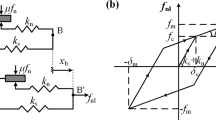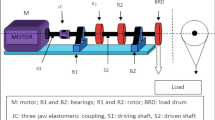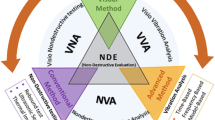Abstract
Background
The research on machine tool vibration has significant impact to improve the processing quality of the processed parts. The vibration response on the surface quality is quite different based on different modes of vibration.
Purpose
Current study proposed a new approach of modes decoupling based on Operational Deflection Shape (ODS) and structural sensitivity analysis, which used to identify the structural vibrations on surface topography in manufacturing process. Method According to the modes decoupling based on the ODS method, the dominant vibration frequencies of machine tool are identified in a wide range of frequency band. Furthermore, the modal mass distribution matrix analysis is used to determine the sensitive structures that cause greater machining errors. A milling process is used to conduct experiments.
Results
The experimental and theoretical results indicate that (i) the contribution of dominant vibration frequency to the vibration of machine tool is larger than weak modes vibration and (ii) the sensitive structure has higher vibration energy than the insensitive structures.
Conclusion
The multimode vibration at dominant frequencies of the sensitive structures (MVDFSS) directly can determine the surface topography of the products.










Similar content being viewed by others
References
Cheung CF, Lee WB (2000) Study of factors affecting the surface quality in ultraprecision diamond turning. Mater Manuf Process 15:481–502
To S, Cheung CF, Lee WB (2001) Influence of material swelling on surface roughness in diamond turning of single crystals. Met Sci J 17:102–108
Liu K, Melkote SN (2006) Effect of plastic side flow on surface roughness in micro-turning process. Int J Mach Tools Manuf 46:1778–1785
Cheung CF, To S, Lee WB (2002) Anisotropy of surface roughness in diamond turning of brittle single crystals. Adv Manuf Process 17:251–267
Parus A, Bodnar A, Marchelek K, Chodzko M (2015) Using of active clamping device for workpiece vibration suppression. J Vib Eng Technol 3(2):161–167
Xiao W, Mao K, Zhu M, Li B, Lei S, Pan X (2014) Modelling the spindle–holder taper joint in machine tools: a tapered zero-thickness finite element method. J Sound Vib 333:5836–5850
Liu X, Sun B, Xue F, Li L (2016) Identification of nonlinear parameter of mechanical joint system based on vibration tests. J Vib Eng Technol 4:475–482
Wang H, To S, Chan CY (2013) Investigation on the influence of tool-tip vibration on surface roughness and its representative measurement in ultra-precision diamond turning. Int J Mach Tools Manuf 69:20–29
Arizmendi M, Campa FJ, Fernández J (2009) Model for surface topography prediction in peripheral milling considering tool vibration. CIRP Ann Manuf Technol 58:93–96
Cheung CF, Lee WB (2000) A theoretical and experimental investigation of surface roughness formation in ultra-precision diamond turning. Int J Mach Tools Manuf 40:979–1002
Zhang SJ, To S (2013) A theoretical and experimental investigation into multimode tool vibration with surface generation in ultra-precision diamond turning. Int J Mach Tools Manuf 72:32–36
Shore P, Morantz P, Luo X (2005) Big OptiX ultra precision grinding/measuring system. Proc SPIE 5965:241–248
Chen W, Lu L, Yang K, Su H, Chen G (2016) An experimental and theoretical investigation into multimode machine tool vibration with surface generation in fly cutting. Proc Inst Mech Eng Part B J Eng Manuf 230:2439–2452
Abuthakeer SS, Mohanram PV, Mohankumar G (2011) The effect of spindle vibration on surface roughness of workpiece in dry turning using ANN. Int Lean Think 2:1–16
Zhang SJ, To S, Wang HT (2013) A theoretical and experimental investigation into five-DOF dynamic characteristics of an aerostatic bearing spindle in ultra-precision diamond turning. Int J Mach Tools Manuf 71:1–10
Zhang SJ, To S (2013) A theoretical and experimental study of surface generation under spindle vibration in ultra-precision raster milling. Int J Mach Tools Manuf 75:36–45
Zhang SJ, To S (2013) The effects of spindle vibration on surface generation in ultra-precision raster milling. Int J Mach Tools Manuf 71:52–56
Cheng Q, Zhao H, Zhang G, Gu P, Cai L (2014) An analytical approach for crucial geometric errors identification of multi-axis machine tool based on global sensitivity analysis. Int J Adv Manuf Technol 75:107–121
Chen G, Liang Y, Sun Y, Chen W, Wang B (2013) Volumetric error modeling and sensitivity analysis for designing a five-axis ultra-precision machine tool. Int J Adv Manuf Technol 68:2525–2534
Chen GP, Wen GL (2014) Dynamic sensitivity research for the spindle of high-speed grinder based on the artificial neural network. Appl Mech Mater 628:257–260
Wu HQ, Wang WQ (2013) The improved design of machine tool structure based on sensitivity analysis. Appl Mech Mater 423–426:1929–1935
Siddhpura M, Paurobally R (2012) A review of chatter vibration research in turning. Int J Mach Tools Manuf 61:27–47
Tansel IN, Li M, Demetgul M, Bickraj K, Kaya B, Ozcelik B (2012) Detecting chatter and estimating wear from the torque of end milling signals by using index based reasoner (IBR). Int J Adv Manuf Technol 58:109–118
Dombovari Z, Lglesias A, Zatarain M, Insperger T (2011) Prediction of multiple dominant chatter frequencies in milling processes. Int J Mach Tools Manuf 51:457–464
Dhupia J, Powalka B, Katz R, Ulsoy AG (2007) Dynamics of the arch-type reconfigurable machine tool. Int J Mach Tools Manuf 47:326–334
Shin YC, Eman KF, Wu SM (1989) Experimental complex modal analysis of machine tool structures. J Eng Ind 111:116–124
Schwarz BJ, Richardson MH (2004) Measurements required for displaying operating deflection shapes. In: IMAC XXII, pp 1–6
Zhi CO, Eng HC, Noroozi S (2017) Non-destructive testing and assessment of a piping system with excessive vibration and recurrence crack issue: an industrial case study. Eng Fail Anal 82:280–297
Bae W, Kyong Y, Dayou J, Kyi-hwan Park SW (2011) Scaling the operating deflection shapes obtained from scanning laser doppler vibrometer. J Nondestruct Eval 30:91–98
Liu JQ, Wang YF, Xu W (2017) A multi-resolution dynamics feature relying on operating deflection shapes for identifying interface debondings in steel-reinforced concrete structures. J Vibroengineering 19:5104–5113
Mao XY, Liu QX, Li B, Liu HQ (2016) Investigation on the dynamic behavior of machine tool with respect to different worktable feed rates. In: 2016 7th international conference on mechanical and aerospace engineering (ICMAE). IEEE, pp 253–256
Acknowledgements
This work is supported by the National Nature Science Foundation of China under Grant no. 51505084, and the National Natural Science Foundation of Guangdong, China under Grant no. 2016A030313133, and the Research start-up funds of DGUT under Grant no. GC300502-61, and the Guangdong Provincial Key Laboratory construction project of China under Grant nos. 2011A060901026 and 2017B030314146).
Author information
Authors and Affiliations
Corresponding author
Additional information
Publisher's Note
Springer Nature remains neutral with regard to jurisdictional claims in published maps and institutional affiliations.
Rights and permissions
About this article
Cite this article
Yin, L., Liu, Q., Zhang, F. et al. Study for the Identification of Dominant Frequencies and Sensitive Structure on Machine Tools Using Modal Decoupling and Structural Sensitivity Analysis. J. Vib. Eng. Technol. 7, 507–517 (2019). https://doi.org/10.1007/s42417-019-00172-7
Received:
Accepted:
Published:
Issue Date:
DOI: https://doi.org/10.1007/s42417-019-00172-7




